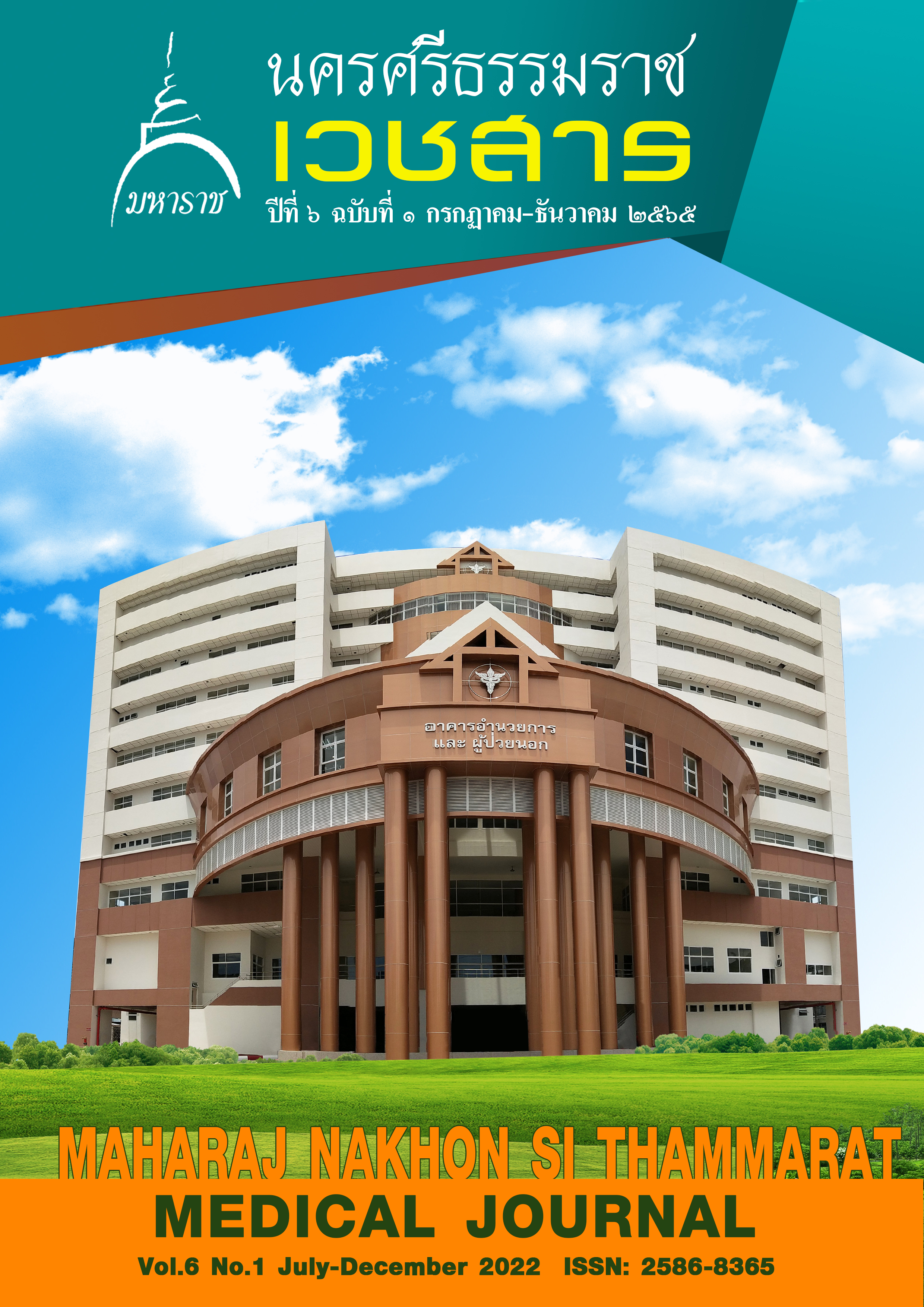ปัจจัยที่มีผลต่อการเสียชีวิตของผู้ป่วยกล้ามเนื้อหัวใจตายเฉียบพลันชนิด ST Elevation ที่ได้รับการรักษาสวนหัวใจในโรงพยาบาลมหาราชนครศรีธรรมราช
คำสำคัญ:
โรคกล้ามเนื้อหัวใจตายเฉียบพลัน, การเสียชีวิตบทคัดย่อ
บทนำ : โรคกล้ามเนื้อหัวใจตายเฉียบพลันชนิด ST Elevation เป็นโรคที่มีการเสียชีวิตสูงแต่ถ้าผู้ป่วยได้รับการรักษาเปิดหลอดเลือดหัวใจอย่างรวดเร็ว รวมถึงรู้ปัจจัยที่มีผลทำให้ผู้ป่วยเสียชีวิตก็สามารถช่วยป้องกันรักษาทำให้เพิ่มอัตราการรอดชีวิตของผู้ป่วยได้
วัตถุประสงค์ : เพื่อศึกษาปัจจัยที่มีผลต่อการเสียชีวิตของผู้ป่วยกล้ามเนื้อหัวใจตายเฉียบพลันชนิด ST Elevation ที่ได้รับการรักษาสวนหัวใจในโรงพยาบาลมหาราชนครศรีธรรมราช
วัสดุและวิธีการศึกษา : การศึกษาเป็นแบบ Cross-sectional ของผู้ป่วยกล้ามเนื้อหัวใจตายเฉียบพลันชนิด ST Elevation โดยผู้ป่วยได้รับการรักษาสวนหัวใจในโรงพยาบาล ระหว่างวันที่ 1 กรกฏาคม 2561 ถึง 30 กันยายน 2562
ผลการศึกษา : ผู้ป่วยจำนวน 98 ราย ผู้ป่วยเสียชีวิต จำนวน 23% พบว่าผู้ป่วยภาวะ Killip class IV 69.6% Cardiogenic shock 82.6% ค่าของไตผิดปกติก่อนการสวนหัวใจ หรือ หลังจากการสวนหัวใจ มีค่าของไตผิดปกติ และ ค่า cardiac troponin สูง เป็นปัจจัยที่มีผลต่อการเสียชีวิตของผู้ป่วยอย่างมีนัยสำคัญทางสถิติ หลังจาการสวนหัวใจพบว่าผู้ป่วยมีภาวะ หัวใจวาย (Odd ratio 115.5) มีเลือดออก (Odd ratio 4.93) และใส่ท่อช่วยหายใจ (Odd ratio 161) เป็นปัจจัยเสี่ยงต่อการเสียชีวิต
สรุป : จากการศึกษาพบว่า ก่อนการสวนหัวใจ ผู้ป่วยมีภาวะ Killip class IV Cardiogenic shock ค่าการทำงานของไตที่ผิดปกติ หรือ หลังจากการสวนหัวใจ ค่าการทำงานของไตที่ผิดปกติ ค่า cardiac troponin สูง ภาวะหัวใจวาย มีเลือดออก และใส่ท่อช่วยหายใจ เป็นปัจจัยที่มีผลต่อการเสียชีวิตของผู้ป่วยกล้ามเนื้อหัวใจตายเฉียบพลันชนิดST Elevation ที่ได้รับการรักษาสวนหัวใจในโรงพยาบาลมหาราชนครศรีธรรมราช
คำสำคัญ : โรคกล้ามเนื้อหัวใจตายเฉียบพลัน การเสียชีวิต
เอกสารอ้างอิง
Sanguanwong S, Srimahachota S, Tungsubutra W, Srichaiveth B, Kiatchoosakun S. Predictors of in-hospital mortality in Thai STEMI patients: results from TACSR. J Med Assoc Thai 2007; 90 Suppl 1: 91-7.
DeWood MA, Spores J, Notske R, Mouser LT, Burroughs R, Golden MS, et al. Prevalence of total coronary occlusion during the early hours of transmural myocardial infarction. N Engl J Med 1980; 303: 897-902.
Boersma E, Mercado N, Poldermans D, Gardien M, Vos J, Simoons ML. Acute myocardial infarction. Lancet 2003; 361(9360): 847-58.
Chotechuang Y, Phrommintikul A, Kuanprasert S, Muenpa R, Patumanond J, Chaichuen T, et al. Cardiovascular outcomes of early versus delayed coronary intervention in low to intermediate-risk patients with STEMI in Thailand: a randomised trial. Heart Asia 2019; 11(2): e011201.
Jolly SS, Amlani S, Hamon M, Yusuf S, Mehta SR. Radial versus femoral access for coronary angiography or intervention and the impact on major bleeding and ischemic events: a systematic review and meta-analysis of randomized trials. Am Heart J 2009; 157(1): 132-40.
Abdelaal E, Brousseau-Provencher C, Montminy S, Plourde G, MacHaalany J, Bataille Y, et al. Risk score, causes, and clinical impact of failure of transradial approach for percutaneous coronary interventions. JACC Cardiovasc Interv 2013; 6(11): 1129-37.
Rathore S, Stables RH, Pauriah M, Hakeem A, Mills JD, Palmer ND, et al. Impact of length and hydrophilic coating of the introducer sheath on radial artery spasm during transradial coronary intervention: a randomized study. JACC Cardiovasc Interv 2010; 3(5): 475-83.
Goldberg SL, Renslo R, Sinow R, French WJ. Learning curve in the use of the radial artery as vascular access in the performance of percutaneous transluminal coronary angioplasty. Cathet Cardiovasc Diagn 1998; 44(2): 147-52.
Kiemeneij F. Prevention and management of radial artery spasm. J Invasive Cardiol 2006; 18(4): 159-60.
Rogers TL, Ostrow CL. The use of EMLA cream to decrease venipuncture pain in children. J Pediatr Nurs 2004; 19(1): 33-9.
Joly LM, Spaulding C, Monchi M, Ali OS, Weber S, Benhamou D. Topical lidocaine-prilocaine cream (EMLA) versus local infiltration anesthesia for radial artery cannulation. Anesth Analg 1998; 87(2): 403-6.
Young SS, Schwartz R, Sheridan MJ. EMLA cream as a topical anesthetic before office phlebotomy in children. South Med J 1996; 89(12): 1184-7.
Schreiber S, Ronfani L, Chiaffoni GP, Matarazzo L, Minute M, Panontin E, et al. Does EMLA cream application interfere with the success of venipuncture or venous cannulation? A prospective multicenter observational study. Eur J Pediatr 2013; 172(2): 265-8.
Yamamoto LG, Boychuk RB. A blinded, randomized, paired, placebo-controlled trial of 20-minute EMLA cream to reduce the pain of peripheral i.v. cannulation in the ED. Am J Emerg Med 1998; 16(7): 634-6.
Smith M, Gray BM, Ingram S, Jewkes DA. Double-blind comparison of topical lignocaine-prilocaine cream (EMLA) and lignocaine infiltration for arterial cannulation in adults. Br J Anaesth 1990; 65(2): 240-2.
Pirat A, Karaaslan P, Candan S, Zeyneloglu P, Varan B, Tokel K, et al. Topical EMLA cream versus prilocaine infiltration for pediatric cardiac catheterization. J Cardiothorac Vasc Anesth 2005; 19(5): 642-5.
Joly LM, Spaulding C, Monchi M, Ali OS, Weber S, Benhamou D. Topical lidocaine-prilocaine cream (EMLA) versus local infiltration anesthesia for radial artery cannulation. Anesth Analg 1998; 87(2): 403-6.
Latsios G, Toutouzas K, Antonopoulos AS, Melidi E, Synetos A, Vogiatzi G, et al. Anesthetic ointment only (lidocaine/prilocaine) instead of injectable local lidocaine in trans-radial catheterization: A viable no-needle alternative. J Interv Cardiol 2017; 30(4): 382-6.
Vicent L, Velásquez-Rodríguez J, Valero-Masa MJ, Díez-Delhoyo F, González-Saldívar H, Bruña V, et al. Predictors of high Killip class after ST segment elevation myocardial infarction in the era of primary reperfusion. Int J Cardiol 2017; 248: 46-50.
Loncar G, Barthelemy O, Berman E, Kerneis M, Petroni T, Payot L, et al. Impact of renal failure on all-cause mortality and other outcomes in patients treated by percutaneous coronary intervention. Arch Cardiovasc Dis 2015; 108(11): 554-62.
Rasoul S, Nienhuis MB, Ottervanger JP, Slingerland RJ, de Boer MJ, Dambrink JH, et al. Predictors of elevated cardiac troponin T on admission in ST-segment elevation myocardial infarction. Ann Clin Biochem 2006; 43: 281-6.
Kelly DJ, Gershlick T, Witzenbichler B, Guagliumi G, Fahy M, Dangas G, et al. Incidence and predictors of heart failure following percutaneous coronary intervention in ST-segment elevation myocardial infarction: the HORIZONS-AMI trial. Am Heart J 2011; 162(4): 663-70.
Costa R, Trêpa M, Oliveira M, Frias A, Campinas A, Luz A, et al. Heart Failure Incidence Following ST-Elevation Myocardial Infarction. Am J Cardiol 2022; 164: 14-20.
Pham PA, Pham PT, Pham PC, Miller JM, Pham PM, Pham SV. Implications of bleeding in acute coronary syndrome and percutaneous coronary intervention. Vasc Health Risk Manag 2011; 7: 551-67.
ดาวน์โหลด
เผยแพร่แล้ว
รูปแบบการอ้างอิง
ฉบับ
ประเภทบทความ
สัญญาอนุญาต

อนุญาตภายใต้เงื่อนไข Creative Commons Attribution-NonCommercial-NoDerivatives 4.0 International License.
เนื้อหาและข้อมูลในบทความที่ลงตีพิมพ์ในมหาราชนครศรีธรรมราชเวชสาร ถือเป็นข้อคิดเห็นและความรับผิดชอบของผู้เขียนบทความโดยตรงซึ่งกองบรรณาธิการวารสาร ไม่จำเป็นต้องเห็นด้วย หรือร่วมรับผิดชอบใด ๆ
บทความ ข้อมูล เนื้อหา รูปภาพ ฯลฯ ที่ได้รับการตีพิมพ์ในมหาราชนครศรีธรรมราชเวชสาร ถือเป็นลิขสิทธิ์ของมหาราชนครศรีธรรมราชเวชสาร หากบุคคลหรือหน่วยงานใดต้องการนำทั้งหมดหรือส่วนหนึ่งส่วนใดไปเผยแพร่ต่อหรือเพื่อกระทำการใด จะต้องได้รับอนุญาตเป็นลายลักษณ์อักษรจากวารสารมหาราชนครศรีธรรมราชเวชสาร ก่อนเท่านั้น



